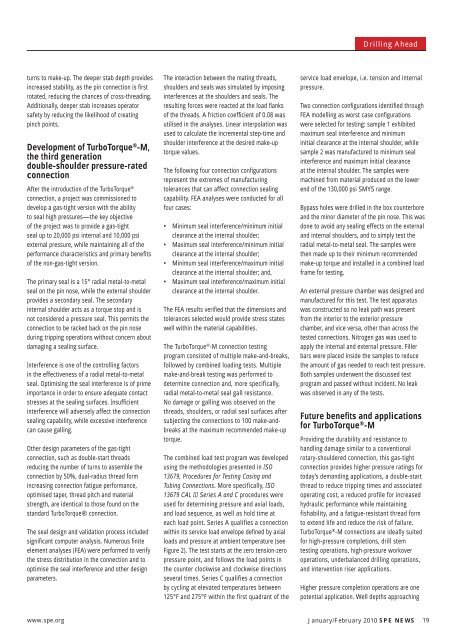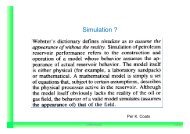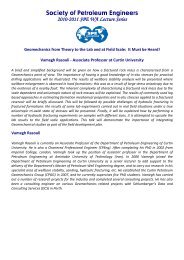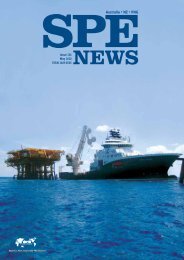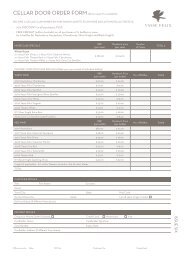Download Issue 131 - January/February 2010 - SPE WA
Download Issue 131 - January/February 2010 - SPE WA
Download Issue 131 - January/February 2010 - SPE WA
- No tags were found...
Create successful ePaper yourself
Turn your PDF publications into a flip-book with our unique Google optimized e-Paper software.
Drilling Aheadturns to make-up. The deeper stab depth providesincreased stability, as the pin connection is fi rstrotated, reducing the chances of cross-threading.Additionally, deeper stab increases operatorsafety by reducing the likelihood of creatingpinch points.Development of TurboTorque ® -M,the third generationdouble-shoulder pressure-ratedconnectionAfter the introduction of the TurboTorque ®connection, a project was commissioned todevelop a gas-tight version with the abilityto seal high pressures—the key objectiveof the project was to provide a gas-tightseal up to 20,000 psi internal and 10,000 psiexternal pressure, while maintaining all of theperformance characteristics and primary benefi tsof the non-gas-tight version.The primary seal is a 15° radial metal-to-metalseal on the pin nose, while the external shoulderprovides a secondary seal. The secondaryinternal shoulder acts as a torque stop and isnot considered a pressure seal. This permits theconnection to be racked back on the pin noseduring tripping operations without concern aboutdamaging a sealing surface.Interference is one of the controlling factorsin the effectiveness of a radial metal-to-metalseal. Optimising the seal interference is of primeimportance in order to ensure adequate contactstresses at the sealing surfaces. Insuffi cientinterference will adversely affect the connectionsealing capability, while excessive interferencecan cause galling.Other design parameters of the gas-tightconnection, such as double-start threadsreducing the number of turns to assemble theconnection by 50%, dual-radius thread formincreasing connection fatigue performance,optimised taper, thread pitch and materialstrength, are identical to those found on thestandard TurboTorque® connection.The seal design and validation process includedsignifi cant computer analysis. Numerous fi niteelement analyses (FEA) were performed to verifythe stress distribution in the connection and tooptimise the seal interference and other designparameters.The interaction between the mating threads,shoulders and seals was simulated by imposinginterferences at the shoulders and seals. Theresulting forces were reacted at the load fl anksof the threads. A friction coeffi cient of 0.08 wasutilised in the analyses. Linear interpolation wasused to calculate the incremental step-time andshoulder interference at the desired make-uptorque values.The following four connection confi gurationsrepresent the extremes of manufacturingtolerances that can affect connection sealingcapability. FEA analyses were conducted for allfour cases:• Minimum seal interference/minimum initialclearance at the internal shoulder;• Maximum seal interference/minimum initialclearance at the internal shoulder;• Minimum seal interference/maximum initialclearance at the internal shoulder; and,• Maximum seal interference/maximum initialclearance at the internal shoulder.The FEA results verifi ed that the dimensions andtolerances selected would provide stress stateswell within the material capabilities.The TurboTorque ® -M connection testingprogram consisted of multiple make-and-breaks,followed by combined loading tests. Multiplemake-and-break testing was performed todetermine connection and, more specifically,radial metal-to-metal seal gall resistance.No damage or galling was observed on thethreads, shoulders, or radial seal surfaces aftersubjecting the connections to 100 make-andbreaksat the maximum recommended make-uptorque.The combined load test program was developedusing the methodologies presented in ISO13679, Procedures for Testing Casing andTubing Connections. More specifically, ISO13679 CAL III Series A and C procedures wereused for determining pressure and axial loads,and load sequence, as well as hold time ateach load point. Series A qualifies a connectionwithin its service load envelope defi ned by axialloads and pressure at ambient temperature (seeFigure 2). The test starts at the zero tension-zeropressure point, and follows the load points inthe counter clockwise and clockwise directionsseveral times. Series C qualifies a connectionby cycling at elevated temperatures between125°F and 275°F within the first quadrant of theservice load envelope, i.e. tension and internalpressure.Two connection confi gurations identifi ed throughFEA modelling as worst case confi gurationswere selected for testing: sample 1 exhibitedmaximum seal interference and minimuminitial clearance at the internal shoulder, whilesample 2 was manufactured to minimum sealinterference and maximum initial clearanceat the internal shoulder. The samples weremachined from material produced on the lowerend of the 130,000 psi SMYS range.Bypass holes were drilled in the box counterboreand the minor diameter of the pin nose. This wasdone to avoid any sealing effects on the externaland internal shoulders, and to simply test theradial metal-to-metal seal. The samples werethen made up to their minimum recommendedmake-up torque and installed in a combined loadframe for testing.An external pressure chamber was designed andmanufactured for this test. The test apparatuswas constructed so no leak path was presentfrom the interior to the exterior pressurechamber, and vice versa, other than across thetested connections. Nitrogen gas was used toapply the internal and external pressure. Fillerbars were placed inside the samples to reducethe amount of gas needed to reach test pressure.Both samples underwent the discussed testprogram and passed without incident. No leakwas observed in any of the tests.Future benefits and applicationsfor TurboTorque ® -MProviding the durability and resistance tohandling damage similar to a conventionalrotary-shouldered connection, this gas-tightconnection provides higher pressure ratings fortoday’s demanding applications, a double-startthread to reduce tripping times and associatedoperating cost, a reduced profile for increasedhydraulic performance while maintainingfishability, and a fatigue-resistant thread formto extend life and reduce the risk of failure.TurboTorque ® -M connections are ideally suitedfor high-pressure completions, drill stemtesting operations, high-pressure workoveroperations, underbalanced drilling operations,and intervention riser applications.Higher pressure completion operations are onepotential application. Well depths approachingwww.spe.org<strong>January</strong>/<strong>February</strong> <strong>2010</strong> <strong>SPE</strong> NEWS 19


